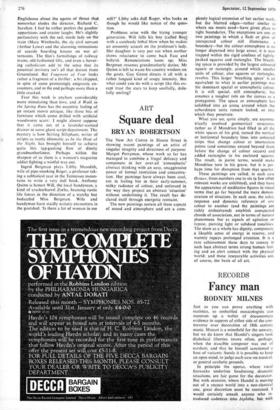ART
Square deal
BRYAN ROBERTSON
The New Art Centre in Sloane Street is showing recent paintings of an artist of singular integrity and directness of purpose: Margot Perryman, whose work so far has managed to combine a frugal delicacy and composure in her over-all 'atmospheric' abstract thinking with an easy, unaggressive power of formal restriction and concentra- tion. Her paintings have always been cool, not in feeling but in their early-summer, milky radiance of colour, and unforced in the way they project an abstract 'situation' without underlining it. The result has de- clared itself through energetic restraint.
The new paintings sustain all these aspects of mood and atmosphere and are a corn-
pletely logical extension of her earlier work; but the blurred edges—rather similar to where sea meets sand—have given place to tight boundaries. The exceptions are one or two paintings in which a flash or glow of unexpected colour still illuminates a boundary—but the colour-atmosphere is no longer dispersed into large areas; it is now trapped within the rigid confines of tightly- packed squares and rectangles. The breath- ing space is provided by the largest coloured square or rectangle, around which smaller units of colour, also squares or rectangles, revolve. This larger 'breathing space' is an equivalent to what in earlier paintings was the dominant spatial or atmospheric colour. It is still spatial, still atmospheric, but assumes a tougher role on the canvas as a protagonist. The space or atmosphere has solidified into an arena around which the subordinate units remain locked, or into which they penetrate.
What you see, quite simply, are asymme- trically resolved geometrical structures, rather as if Mondrian had filled in all the white spaces of his grid, turned the vertical or horizontal boundary lines into coloured strips that change colour at intersection points (and sometimes extend beyond them before the change of colour occurs) and added rectangles to his enclosed squares. The result, in purist terms, would make Mondrian turn in his grave, but it is per- haps time for disruption from that quarter.
These paintings are called, in each case Octave, from numbers one to six (a few other relevant works are exhibited), and they have the appearance of meditative figures in visual terms that go far beyond the mere demon- stration of structure. In each case, the echo, response and dynamic reference of one colour to another (and the paintings are richly orchestrated) establish unexpected chords of association, not in terms of natural phenomena but as signals of agitation or repose, piercing light or subdued tonalities. The show as a whole has dignity, composure, a likeable sense of energy in reserve, and warmly repays prolonged attention. It is a rare achievement these days to convey in such lean abstract terms strong human feel- ing and an alert contact with the physical world; and these inseparable activities are, of course, the basis of all art.














































 Previous page
Previous page